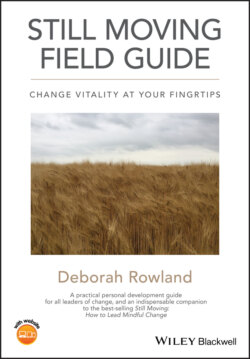Читать книгу Still Moving Field Guide - Deborah Rowland - Страница 6
ОглавлениеAcknowledgments
I have many people to thank who stand behind the writing of this book. First and foremost, I wish to thank my Still Moving colleagues.1 In particular, I thank Michael Thorley, who provided indefatigable and insightful input to the descriptions of each of the Still Moving change leadership elements contained in the book, and Katie Jones, who diligently labored over its production, format, and artistic look and feel. Other colleagues who I'd like to thank are Nicole Brauckmann, Sytske Casimir, Phil Hadridge, Anjet van Linge, Belden Menkus, Darius Norrell, and Paul Pivcevic—not only for their contributions to the book's content, but also for their close work with me over the last 3 years in bringing the “Still Moving way of leading change” into ever‐increasing circles of practical application.
And that's what this Field Guide is for—illuminating how to put into practice, and develop, the skills I wrote of in Still Moving: How to Lead Mindful Change. Thank you, it's been a blast! This book is written from the “we” perspective as its content stands on all of our shoulders.
Widening out, I make a deep bow to the support from Jackie Gittins, who has acted as a wise counsel and champion for us in this work. I am also indebted to Roger Bellis and Helen Bellis for early conceptual development of the “Change Vitality” concept embedded within this Field Guide, including its stunning visual, the “Change Vitality cone”; to Judith Hemming, from whom I have exquisitely learned about the systemic Ordering Forces within our Change Vitality framework—my skill to work at depth as a change practitioner is to a large extent down to her insight and generous mentoring; and to Julian Burton, who is the artist behind the graphics illustrating each of the 16 elements of leading change within this Field Guide.
The Field Guide was originally written to support a growing band of change practitioners who were drawn to the Still Moving philosophy, research, and set of frameworks, which they see as a holistic, fresh take on how to lead change well in today's world. I cannot recall how many approaches I received in the 3 years subsequent to the publication of Still Moving that went along the lines of “I have read your book Still Moving and absolutely loved it. How can I learn more about these capacities and how to deploy them in practice? I want to go further and deeper!”
One way in which we have responded to this pull is to run Still Moving Change Practitioner Programmes—an in‐depth, 4‐day immersion experience into the Still Moving way of “doing” change, followed by application coaching and supervision. The Field Guide developed as an essential reference manual to the content taught in this program, and I'd like to acknowledge here the now‐65 (and climbing) alumni practitioners whose take‐up of the content of the Field Guide gave me the inspiration to publish it for the wider world. Some of their names and messages appear within the book as “Tales From the Field.”
Thank you to all for helping me turn Still Moving from a book about change into a movement to lead change differently—including the practitioners and change leaders who are to come.
Finally, a massive thanks to perhaps my biggest fan, my dad, Ron Rowland. He is always asking me, “What's your next book going to be?”—well, here it is!
Note
1 1 I call them “Still Moving colleagues” as, subsequent to the publication of Still Moving: How to Lead Mindful Change, I discovered from readers and audiences the remarkably intriguing resonance of those two words. So, I renamed my change consultancy to Still Moving.
